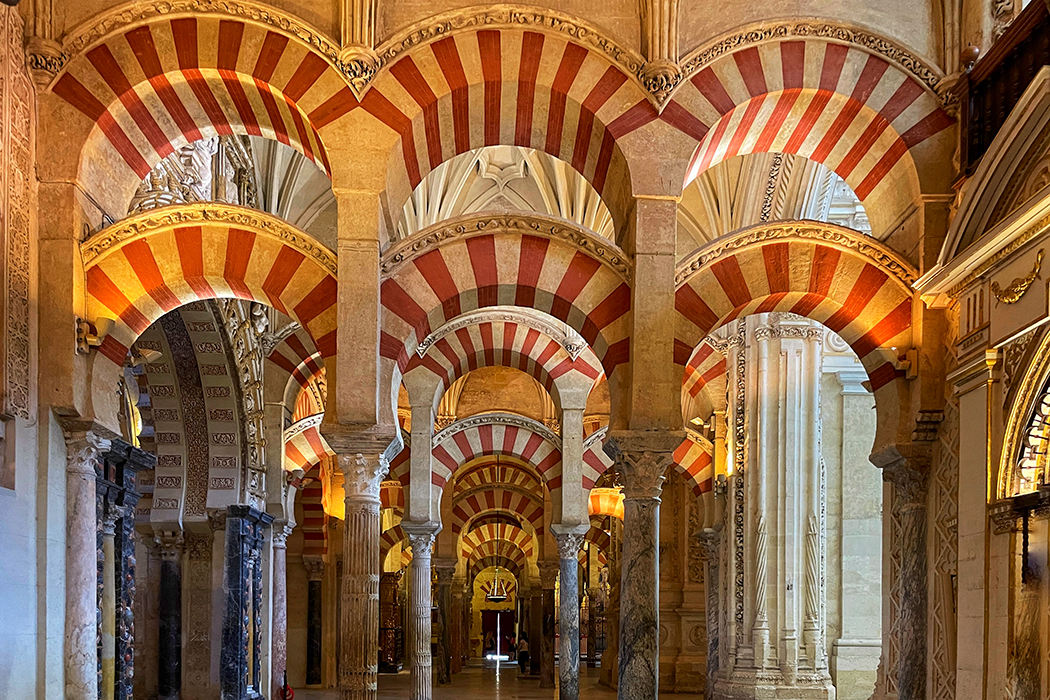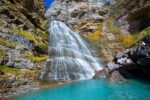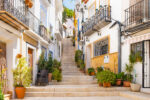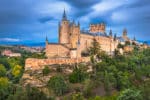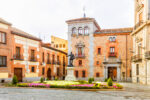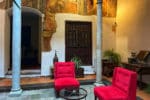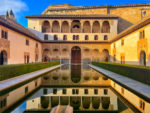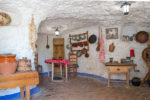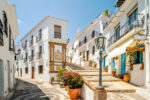The Cordoba Mezquita, also known as the Great Mosque of Cordoba or Cordoba Mosque-Cathedral, is a magnificent structure that has been built, expanded and refined for centuries. The Umayyads built the original mosque between 785 and 988 AD; to this day, it stands as one of the earliest and greatest monuments of Islamic Spain, or Al-Andalus.
This epic monument sits on the foundation of a Roman church; its interior is decorated in a fusion of Arabic and Byzantine styles. In its centre, a mammoth gothic and baroque Cathedral was built by the Christian rulers in the 16th century.
The building has mammoth dimensions. It sprawls over 24,000 square meters, with a forest of 856 columns supporting its stunning double-stacked arches. Of all the things to do in Cordoba, a visit (or two!) to the Mezquita is an absolute must. The structure is a wonder of the world and a pinnacle of Moorish heritage in Cordoba.
This guide provides useful tips for visiting Cordoba Mezquita, including must-see features, several hidden gems and the best time to visit.
Brief History of Umayyads and the Great Mosque of Cordoba
To truly appreciate Cordoba Mezquita, you need to understand a little bit of its history, which starts with the Umayyad dynasty in Damascus, Syria.
After the death of the Prophet Muhammad in 632, the Islamic world was ruled by four successive caliphs who comprised the Rashidun caliphate. After the Rashidun fell, the Umayyad dynasty was born.
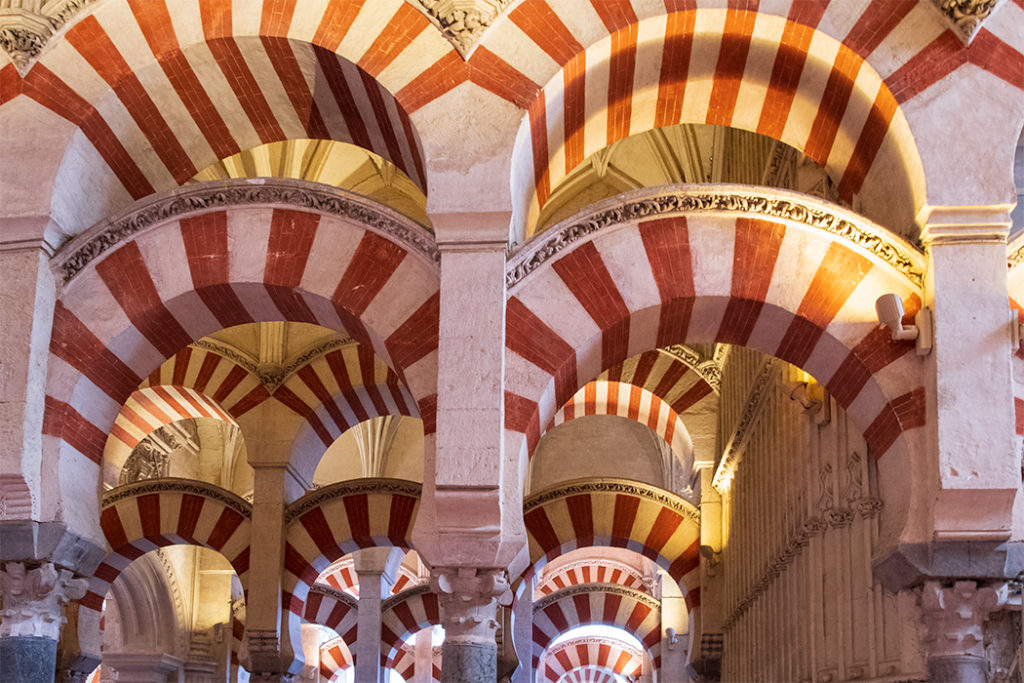
In a fateful event, in 750, less than 100 years after the birth of Islam, the Umayyad caliphate was overthrown by their rivals, the Abbasids. The only survivor from the Umayyad royal family lineage, Abd Al Rahman, the grandson of the last presiding caliph, was 19 years old when he fled Syria.
Five years later, he reached Spain and one year after, he conquered Cordoba and became the first Emir (prince) of Arab Spain or Al-Andalus.
What’s in the name: When the Arabs arrived on the Iberian Peninsula, it was inhabited by Visigoths and Vandals. So the Arabs referred to the peninsula as the Land of the Vandals – Al Andalus.
Thirty years into his rule, in 786, Abd Al Rahman purchased the remnants of the 6th century Roman Church of St Vincent’s from his Christian subjects, demolished it and began the construction of a great mosque as a symbol of political, military, and religious power of the Umayyads.
The columns from the church of St Vincent and numerous other crumbling churches and palaces in the city were used to decorate the mosque. The original prayer hall could hold up to 5,000 worshipers. Yet over the next two centuries, the mosque would grow to four times its original size.
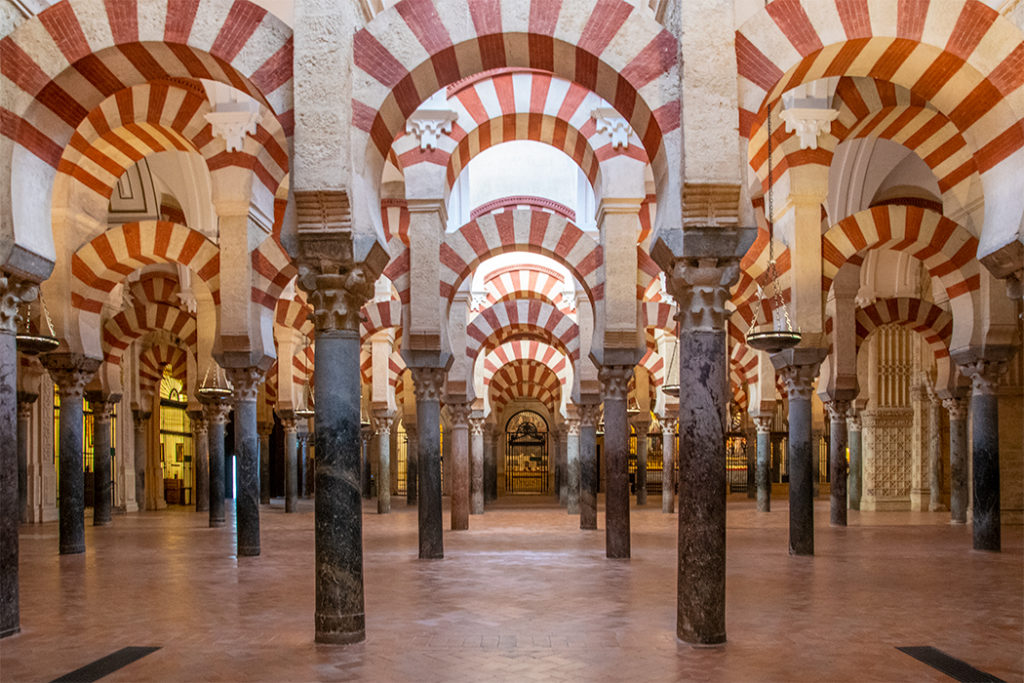
Abd Al Rahman II expanded the mosque in 822 to hold almost 9,500 worshipers. In 929, as the power of the Umayyads grew, Abd al-Rahman III defied the Abbasids by proclaiming himself a Caliph and reasserting his claim to leadership of the Islamic world. And as his first Royal order, he commissioned the second expansion of the mosque.
In 961, Caliph Al-Hakam II initiated the third extension, and in 987, the visier Al-Mansur commissioned the mosque’s final fourth and largest extension.
During the 480 years of Umayyad rule in Cordoba, the Christian monarchs of Spain constantly waged battles with the Arabs in the movement that became known as Reconquista. In 1236, Cordoba finally fell to the Christian forces of Ferdinand III of Castile.
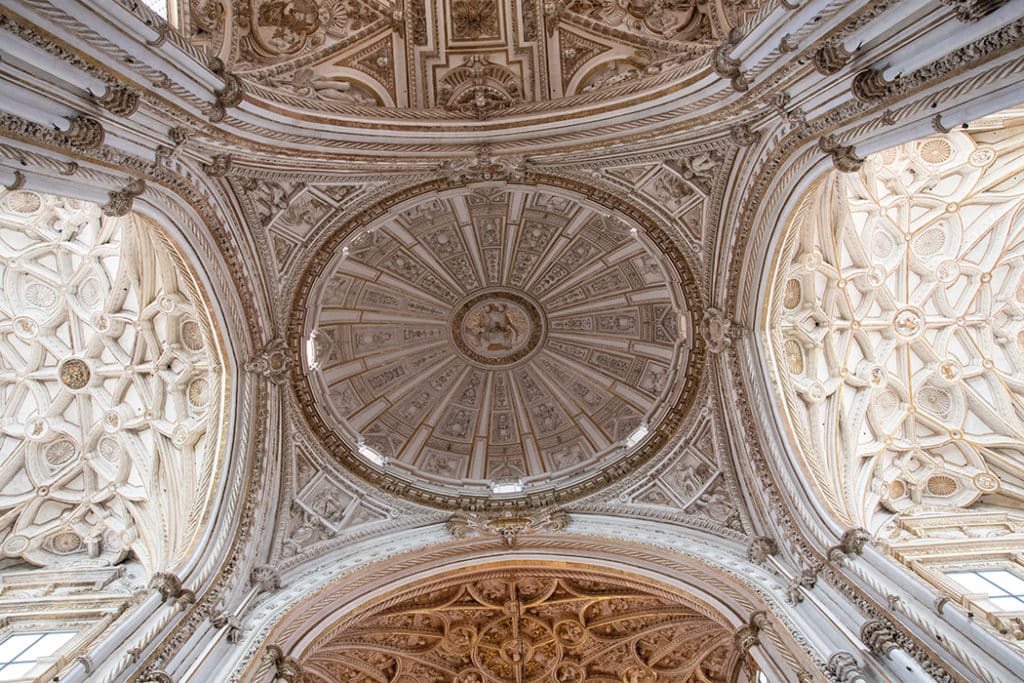
Thankfully, instead of destroying the mosque, Ferdinand III transformed it into a Christian cathedral to symbolize his victory over Islam. At first, a few chapels were added to the mosque walls, and three and a half centuries later, a monumental Gothic cathedral was built into the centre of it.
Useful Information for visiting Cordoba Mezquita
Mezquita Visiting Hours
- March – October: Monday-Saturday from 10:00 am – 7:00 pm; Sunday from 8:30 am – 11:30 pm and 3:00 pm – 7:00 pm.
- November – February: Monday-Saturday from 10.00 am – 6.00 pm; Sunday from 8:30 am – 11:30 pm and 3:00 pm – 6:00 pm.
Mezquita tickets
You can purchase both the Mosque and the Bell Tower tickets on the official Cordoba Mosque-Cathedral website. You do not need to retrieve paper copies of your tickets. Go straight to the entrance and present the QR code for scanning.
Mezquita Audio guides
You can also rent an audio guide at the dedicated kiosk in the Patio de Los Naranjos.
Guided Tours
Given the 12 centuries of history of Cordoba’s Mosque-Cathedral, a guided tour is an excellent way of learning some of this history to truly appreciate the wonder of Cordoba Mezquita. This one is one of the best tours: Skip the line guided tour of Mezquita.
Best time to visit Cordoba Mezquita
The general advice is that the best time to visit the Mezquita is first thing in the morning or last thing in the afternoon. Essentially, you want to avoid the time between 10 am and 4 pm when the tour buses from Sevilla, Granada and Malaga arrive.
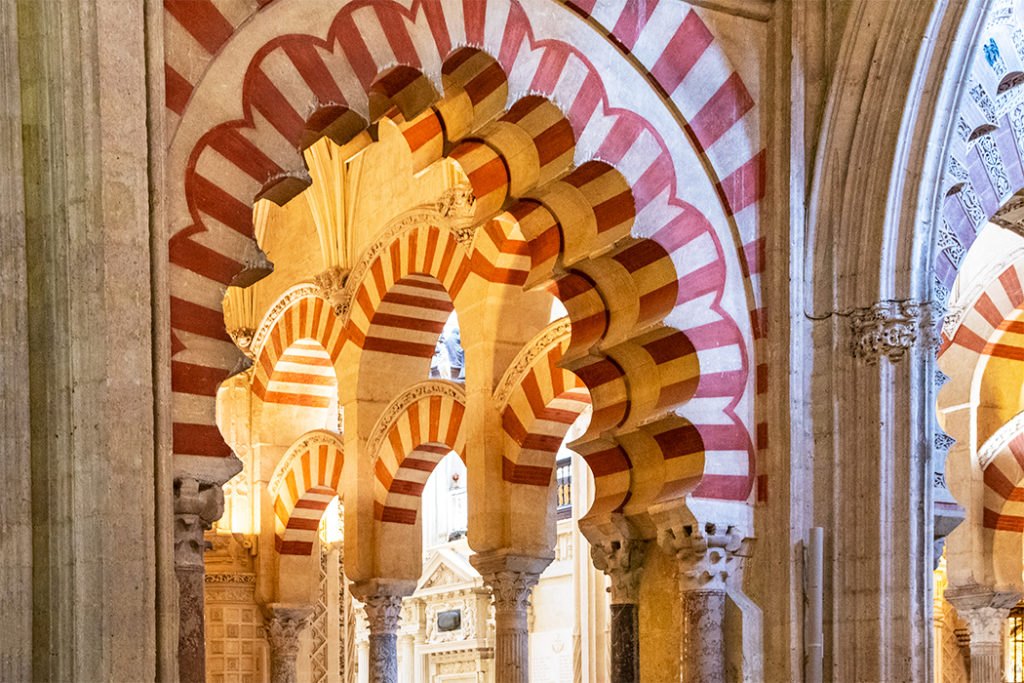
I visited the Mezquita 3 times on my recent trip to Cordoba (yes, it’s that amazing!), and I found the morning time to be crowded and rushed. Visiting in the late afternoon, a couple of hours before the closing time, is a much better idea in my experience.
And don’t miss the night visit – it is an entirely different experience. Read below about each of the experiences, and at the end of the post, I share some hidden gems to look out for on your visit to Cordoba’s Mosque Cathedral.
Mezquita Free Entry – 8.30 am
The 8.30 am free entry to Mezquita is the worst-kept secret in Cordoba. While it’s not advertised on the official website, it seems to be common knowledge on the street.
The first time I visited Mezquita was at 8.30 am. The free entry didn’t matter to me that much, but an opportunity to visit the popular monument without the tour groups did.
When I first arrived at the Santa Catalina gate (Puerta de Santa Catalina), there were just a few of us. By 8.30 am, there were maybe 20 people. But when the gate opened and we entered the courtyard (Patio de Los Naranjos), we were gobsmacked to see dozens of people flowing through all the other gates.
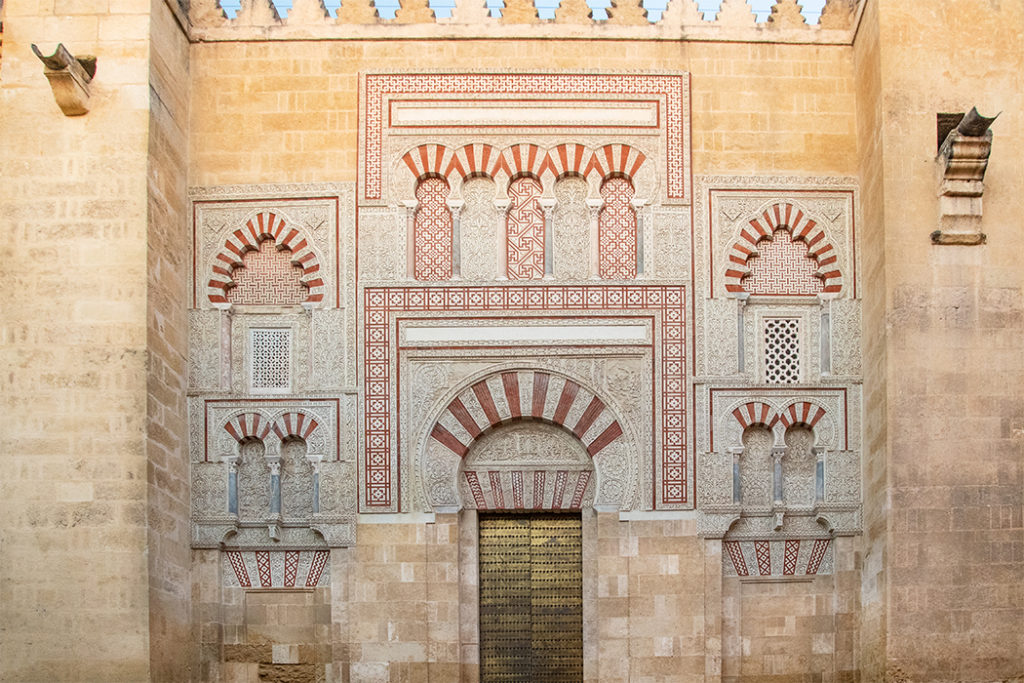
By the time we all made it into the dimly-light interior of the mosque, there were people everywhere. It was not the peaceful experience I imagined.
Another downside to visiting Mezquita at 8.30 am is that you can’t visit the Cathedral because it’s being set up for the 9.30 am Mass service. So effectively, you miss out on seeing the Cathedral half of the Mosque-Cathedral.
And to add insult to injury, security guards start herding you out just before 9.30 am to clear Mezquita for the Mass.
Last Thing in the Afternoon – 5 pm
On my last visit to Mezquita, I opted for the 5 pm slot, 2 hours before closing time. And this was a much more peaceful and complete experience. There were fewer people than in the morning, and even fewer remained as time passed. The Cathedral was open, and you could sit on the benches and stare at the impossibly high Gothic ceiling and the spectacular altar.
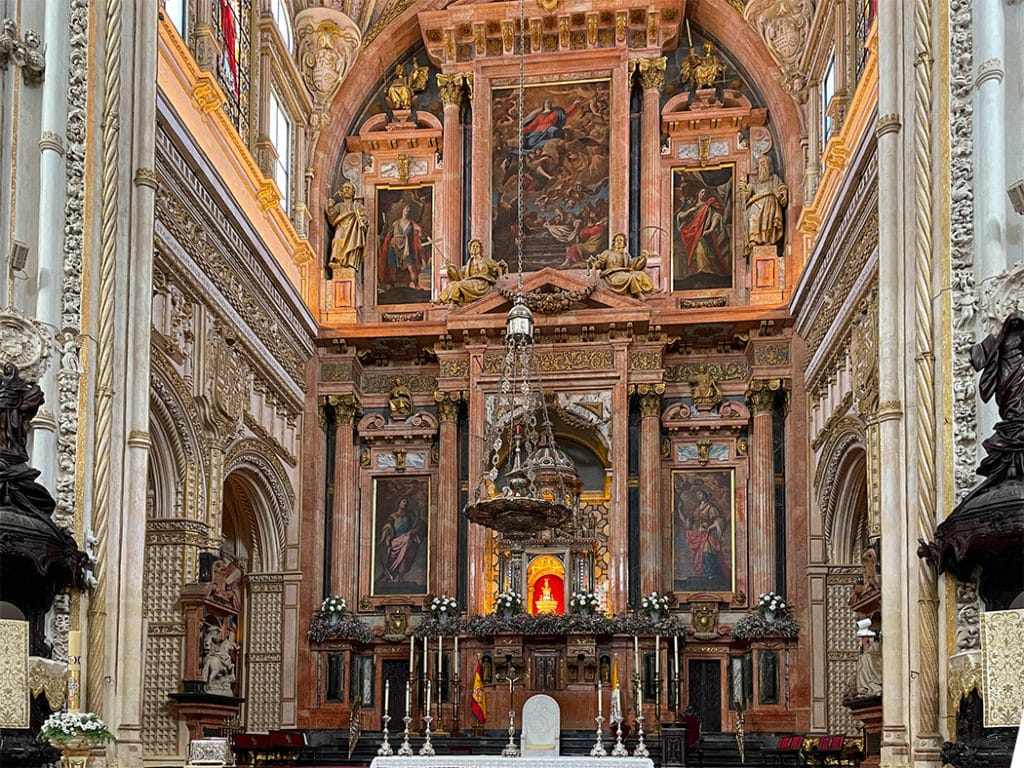
While the cathedral is considered to be an intrusion that compromised the integrity of one of the most unique monuments in the world, it is nonetheless incredibly beautiful. Like the mosque, it was refined over the centuries to achieve its present jaw-dropping magnificence. It is so artfully integrated into the mosque’s structure that it is hardly an eyesore. Missing seeing it on the morning visit is really missing a lot.
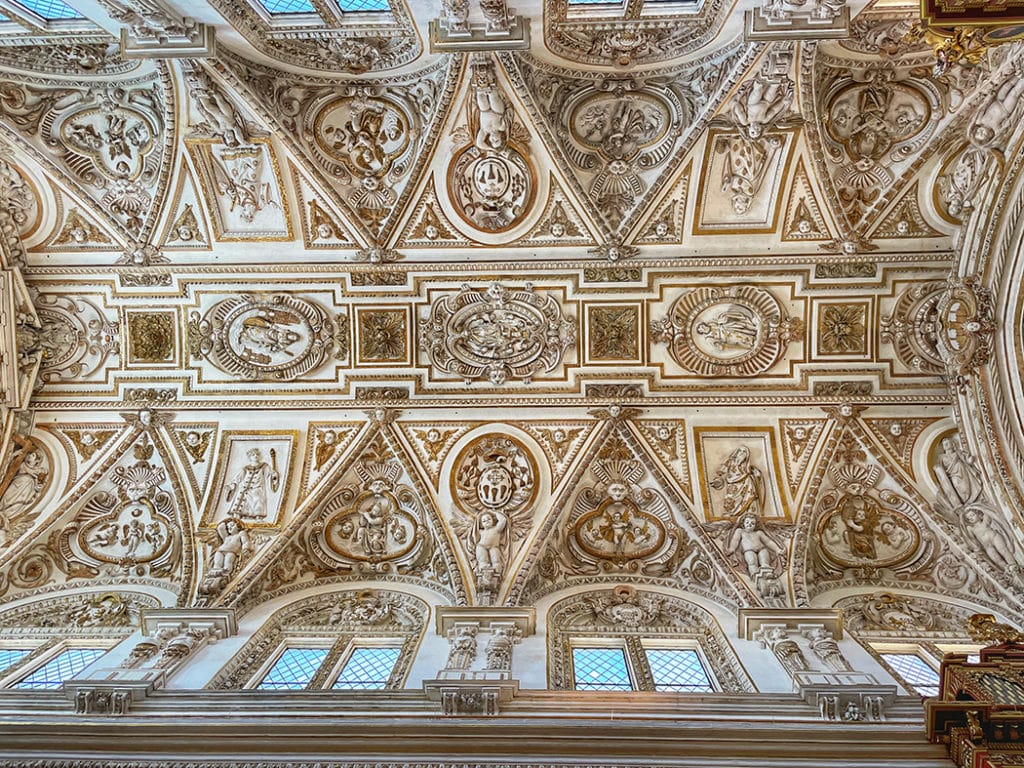
The fact that you don’t have to rush in the afternoon certainly adds to the relaxed experience. You can remain in Mezquita for all of two hours if you wish or leave whenever you are ready.
The Soul of Cordoba – Mezquita at Night – 9 pm
The night-time visit to the Great Mosque of Cordoba is a mesmerizing experience. If you have the chance, I highly recommend returning to Mezquita at night. It was easily the most memorable experience for me in Cordoba.
I suggest first doing the night tour to immerse yourself into the magic of the Great Mosque of Cordoba and then visiting during the day to explore the different features in detail and take photos or videos to your heart’s content (photography is not allowed at night).
Mezquita at night is spellbinding. The experience starts with a short video introduction to the Umayyads and the mosque. You get headphones and a portable player in your preferred language, so you don’t have to listen to everything in two languages.
After the video, you enter the dark interior of the Mezquita. At first, you are engulfed by darkness and the scent of burning incense. Then the arches come to life in a dramatic spotlighting effect, followed by the forest of columns. It is an incredibly atmospheric site.
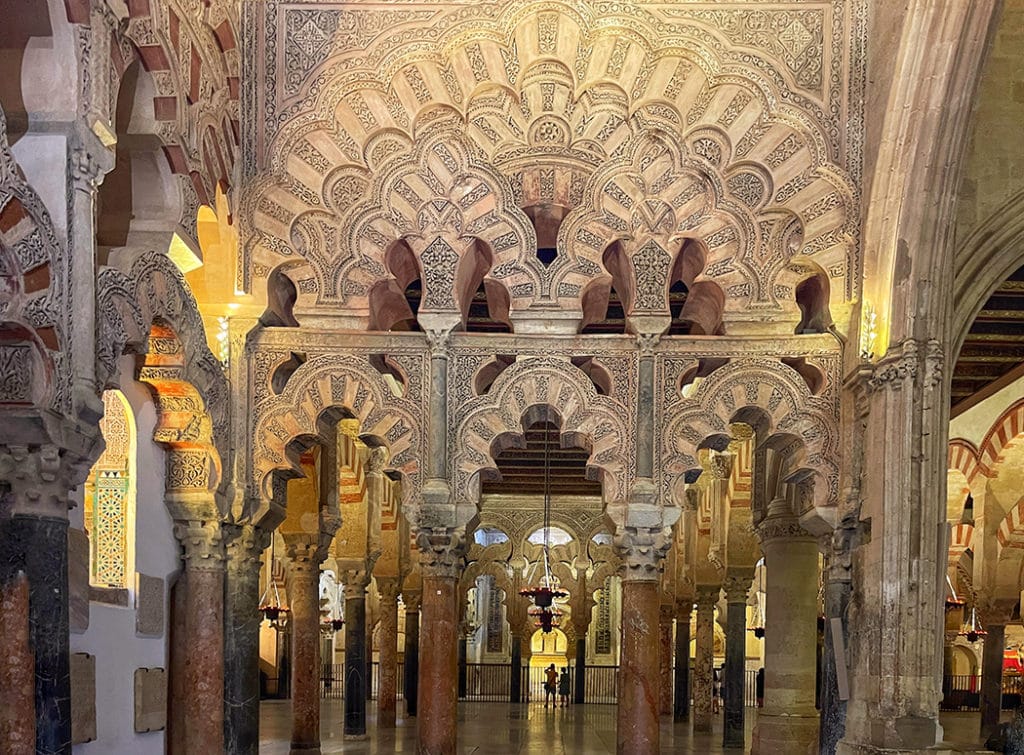
All the while, epic music is playing in your headphones, and National Geographic-style narration takes you on a journey through the centuries of Islamic Spain. It’s like travelling through a story of Thousand and One Nights.
The artfully choreographed light show reveals different features of the achingly beautiful Mezquita, making the structure feel larger than life. The exaggerated contrast between light and darkness highlights the delicate detail of the Mezquita decorations – much of which looks like lace woven from stone.
As the guide leads you through the structure, different areas light up as you approach them, focusing your attention on what the audio recording is presenting. You notice how Byzantine and Arabic styles have been fused in the mosque’s design.
The columns are reminiscent of the Basilica Cistern in Istanbul. The domes bring to mind images of Aya Sophia. And the exquisite mosaic decorations of the Mihrab remind of the magnificent gilded frescos of the Chora church.
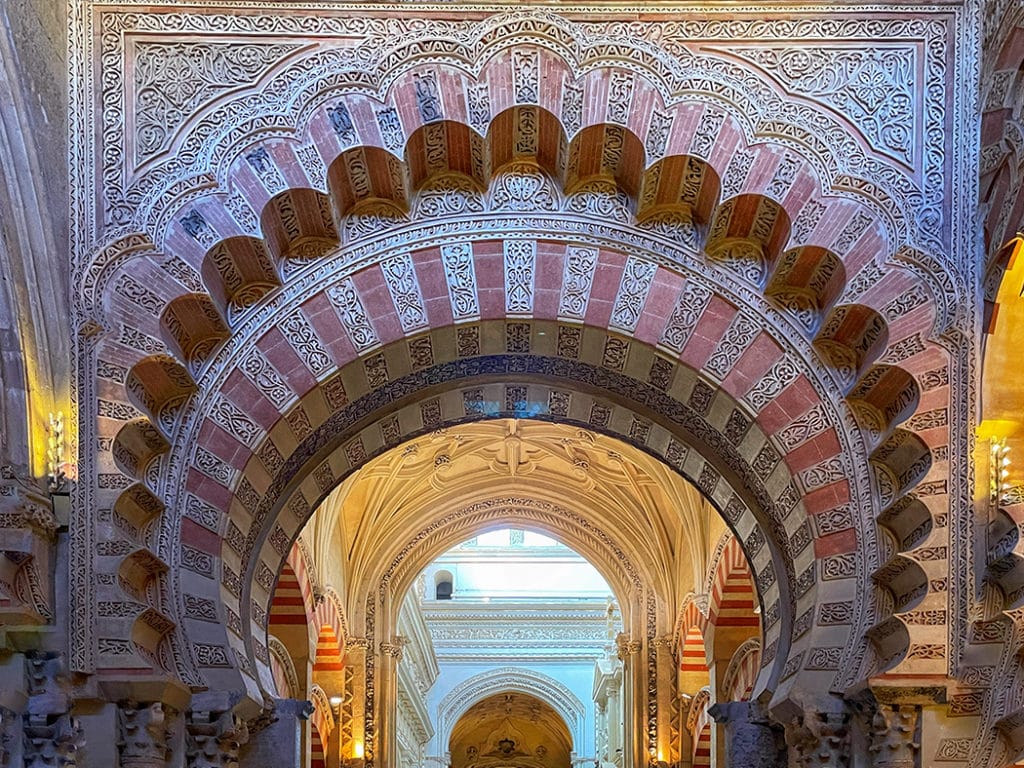
I am not a fan of group tours, but the night visit to the Mezquita is so well thought out, and it is such a huge structure that your small group just dissolves in it. I kept thinking of the Fellowship of the Ring travelling through the Mines of Moria as we walked through the dark colonnades.
To sum up: the Soul of Cordoba is one of the most amazing things to do in Cordoba. A truly unique and memorable experience.
What to see in the Great Mosque of Cordoba
Patio de los Naranjos
Encircled by the towering walls of the Mezquita, the patio of the oranges is one of the oldest walled gardens of the Islamic world that exists today. The garden consists primarily of orange trees with a few palms and cypress trees.
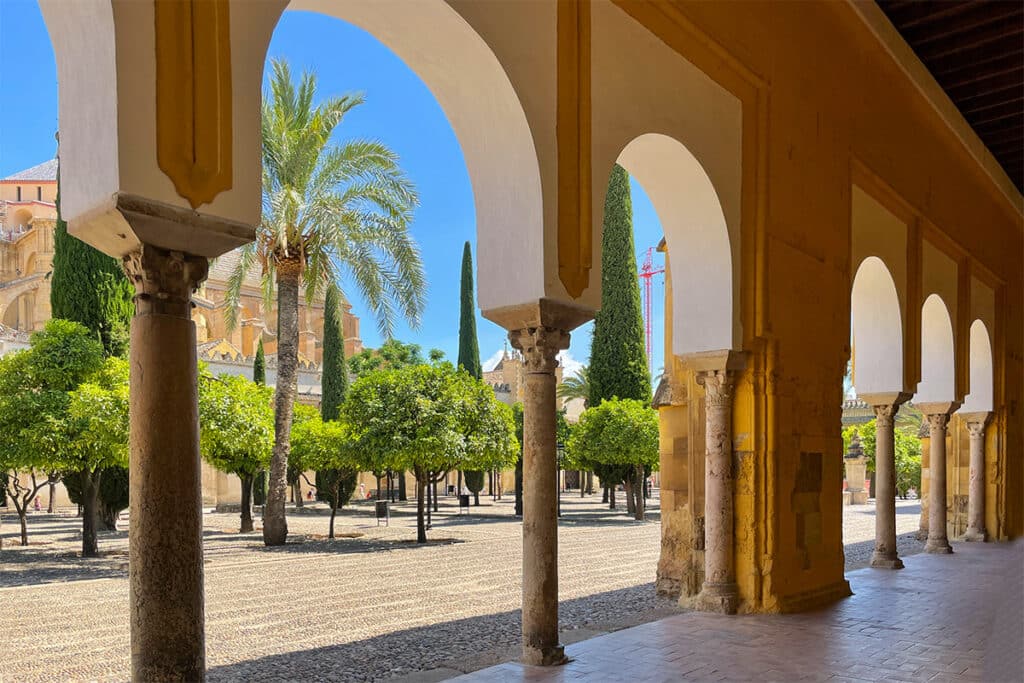
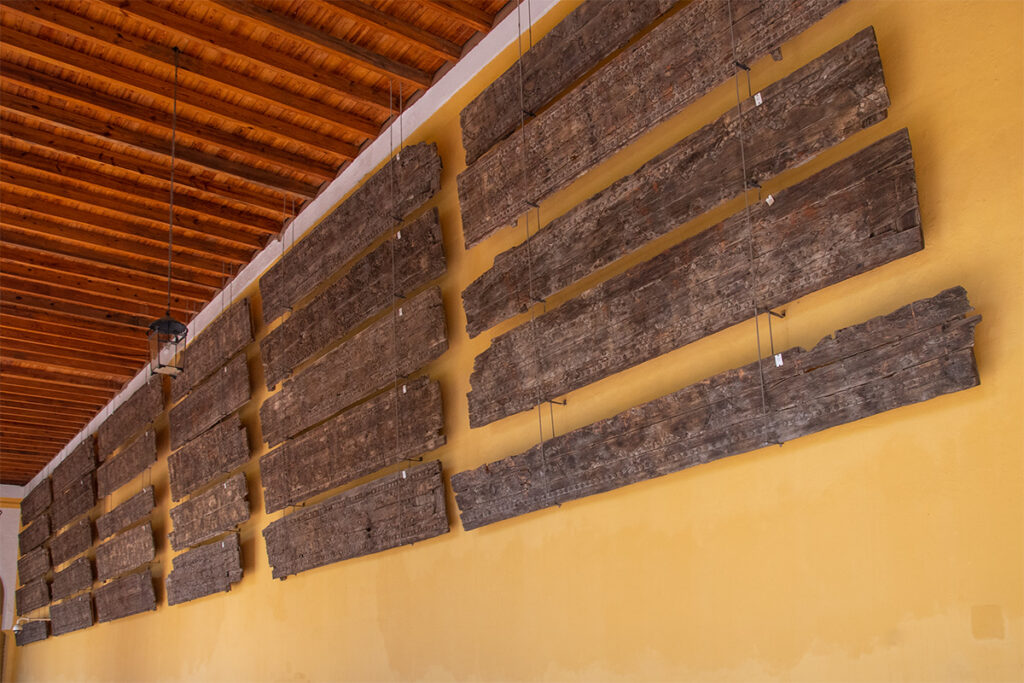
If you visit early in the morning, you can enjoy the garden’s tranquillity with its ornate water features and shaded porticos.
You can see a display of some of the original ceiling panels from the Mezquita on one of the portico walls. In the past, Mezquita had a brightly painted and intricately carved ceiling. Today, the only painted ceiling panels inside the Mezquita can be found above the central aisle.
The oldest part of the Cordoba Mosque
After showing your ticket, the part of Mezquita you enter is the oldest part of the mosque, built by Abd Al Rahman I. This is the most impressive section, so don’t rush through it and have a good look around.
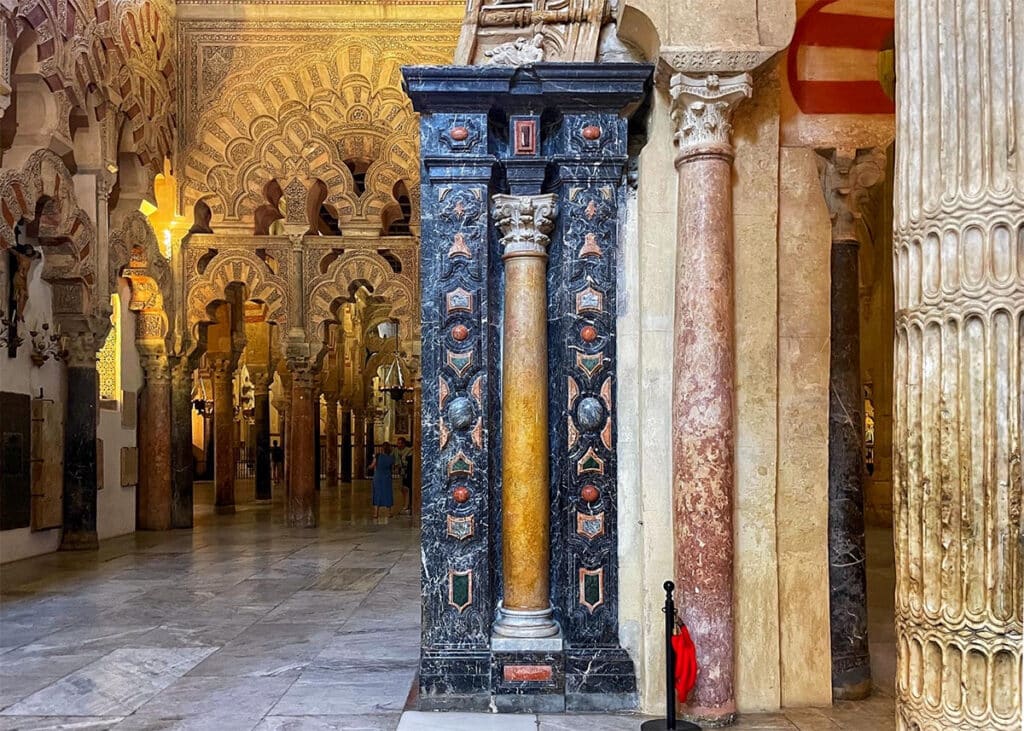
The key features here are the striped double-stacked arches. The upper round arches rest on top of horseshoe-shaped arches that are supported by a forest of columns. You can see the same double-stack pattern in the Roman aqueduct in Segovia. Perhaps this is where the Arabs got their inspiration from. These are the most impressive arches in the Mezquita.
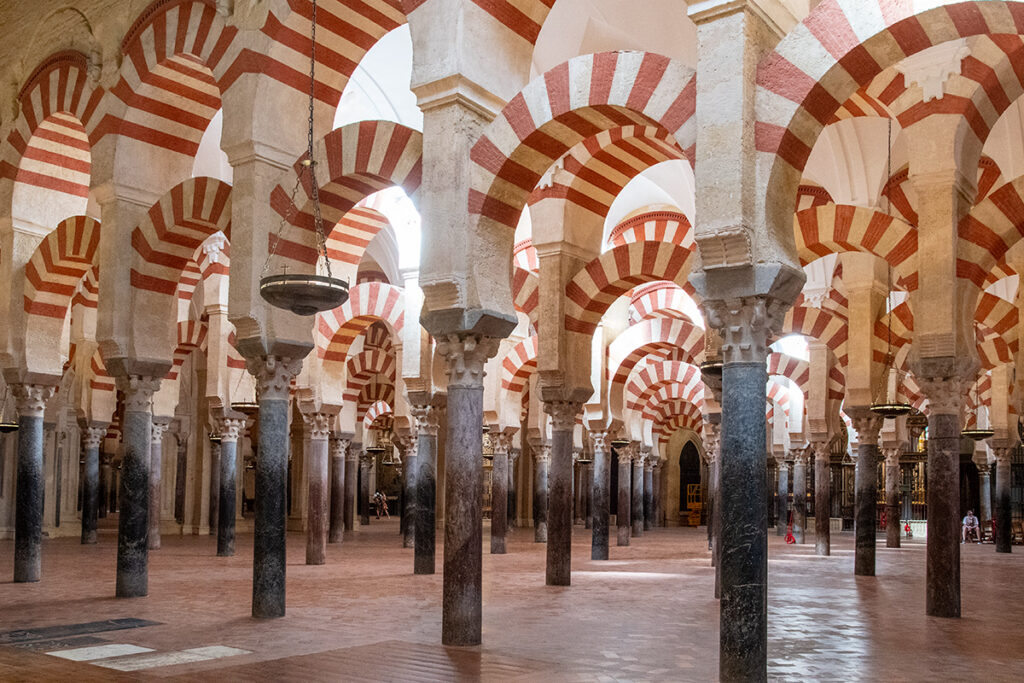
If you look closely, you’ll also notice that the columns are not all the same. Many of them were recycled from the area’s crumbling Roman, Byzantine, and Visigothic structures. Some columns are marble; others are granite or jasper.
The Mihrab
The mihrab is the spiritual heart of the Cordoba mosque and the most lavishly decorated part of the building. It contains an entire room inside that was reserved for the caliph to have his quiet time with god.
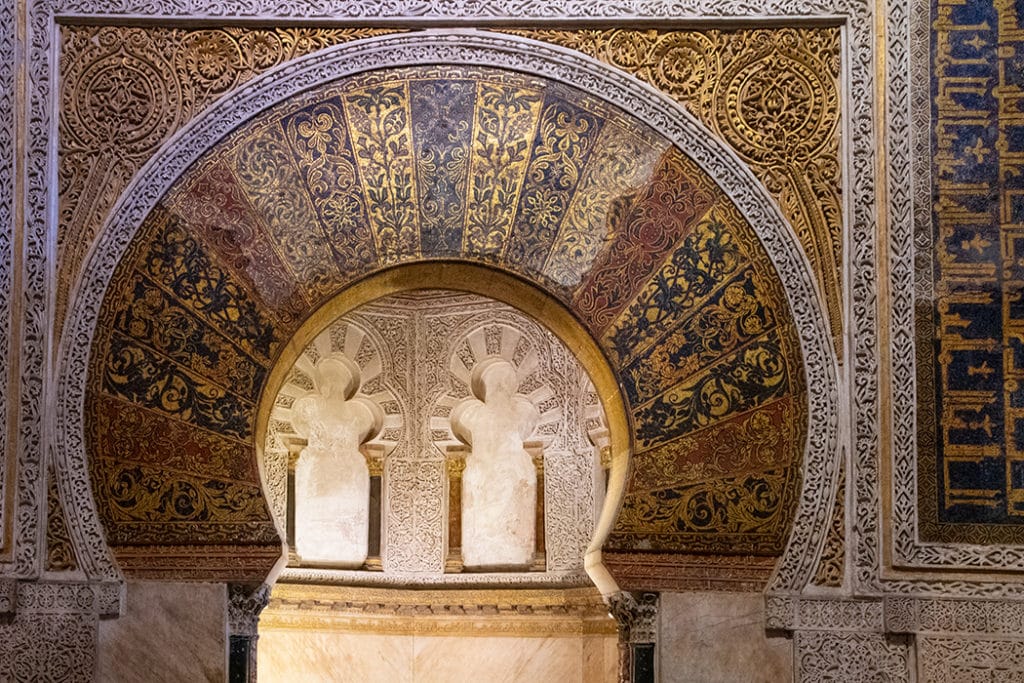
The horseshoe-shaped arch of the entrance portal is laid out with exquisite mosaics that look quite Byzantine in style, matched by an equally Byzantine-looking dome ceiling.
The Cathedral
The cathedral is often considered an intrusion into the artistic integrity of the mosque, but I have to say, it is jaw-dropping in itself, and from a purely artistic point of view, it adds to the mystical air of the mosque.
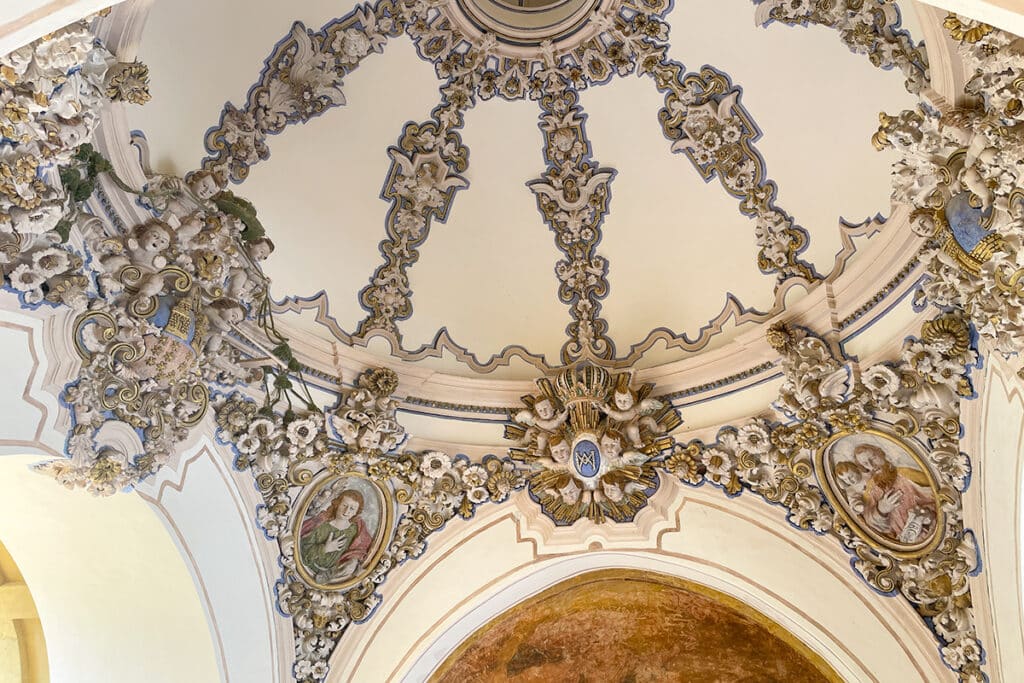
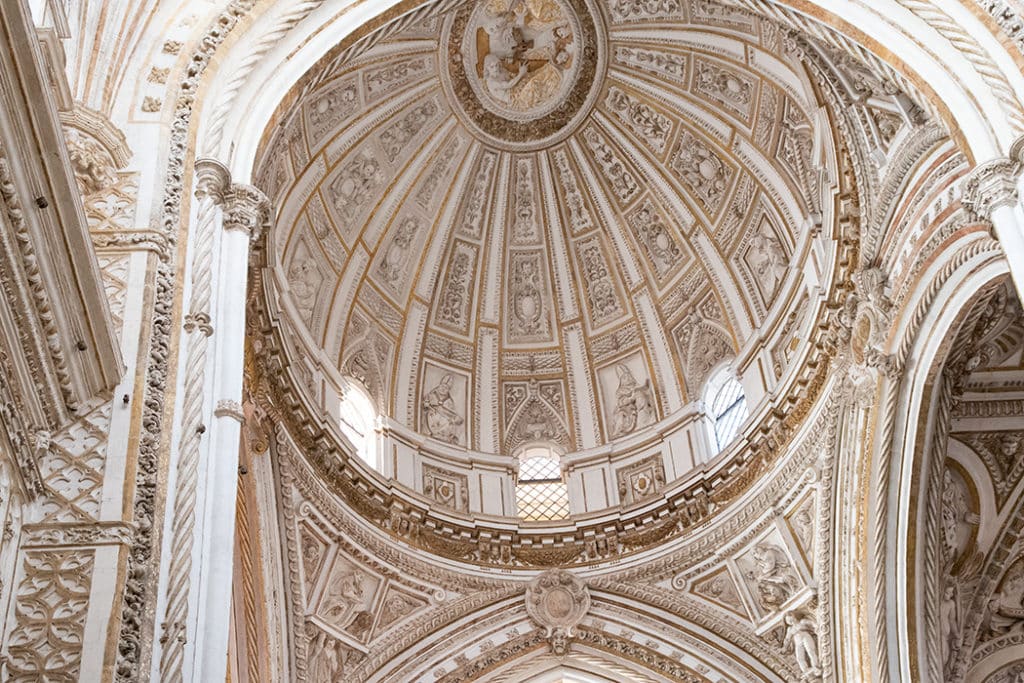
The altar, the choir, and, especially, the ceiling are absolutely stunning. The cathedral is an interesting mix of styles – the building itself is Gothic with its impossibly high ceilings, but the interior decorations are wonderfully baroque.
If you visit outside the mass hours, spend some time sitting on one of the cathedral’s benches to absorb the incredible amount of intricate detail around you. After the comparatively barren walls of the mosque, the liveliness of the baroque cathedral takes some getting used to.
The Bell Tower
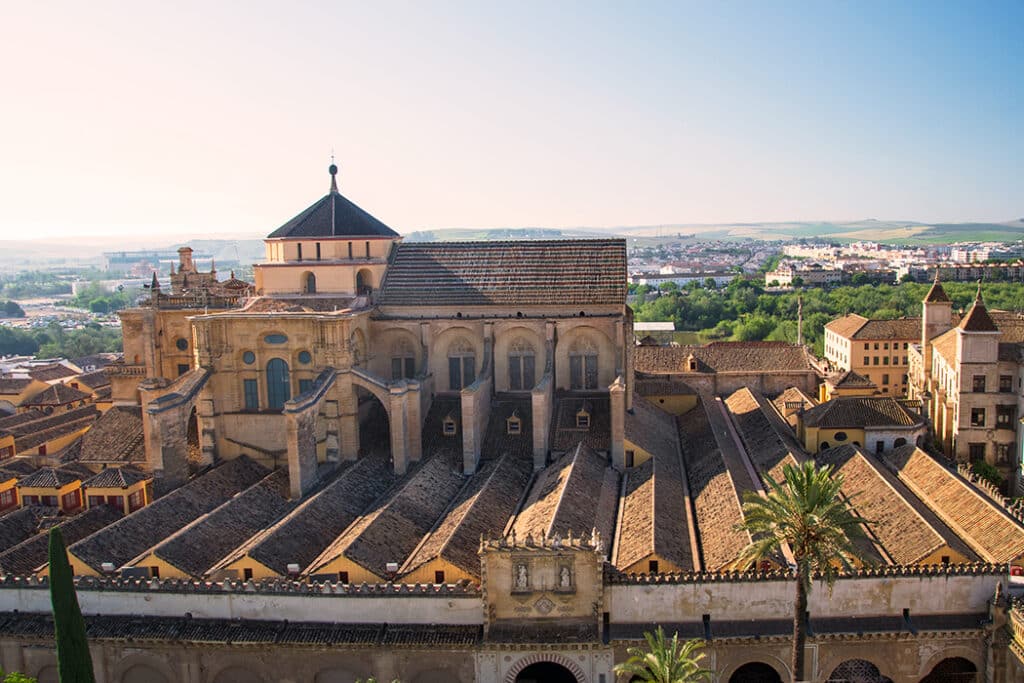
Before we get into the hidden gems, this one is a biggie. If you don’t mind a bit of a climb (200 steps), don’t leave the Mezquita without visiting the Bell Tower for the sweeping views of the old town and the Mezquita itself.
You will need a separate ticket for the bell tower, which you can also buy on the Mezquita website. The first admission to the tower is at 9.30 am, which is the best time to choose if you are a keen photographer. The light gets quite harsh later in the day. The last admission is at 6:00 pm, but it’s best to check the opening times before your visit to avoid disappointment.
Hidden Gems in the Great Mosque of Cordoba
Mezquita is as large as it is beautiful. Its main features – the forest of columns, the Mihrab, and the Cathedral need no introduction. But there are also hidden gems in the structure that can easily be overlooked behind all the splendour.
So, to add an extra element of discovery to your visit, see if you can spot these fascinating gems.
Roman Milestones
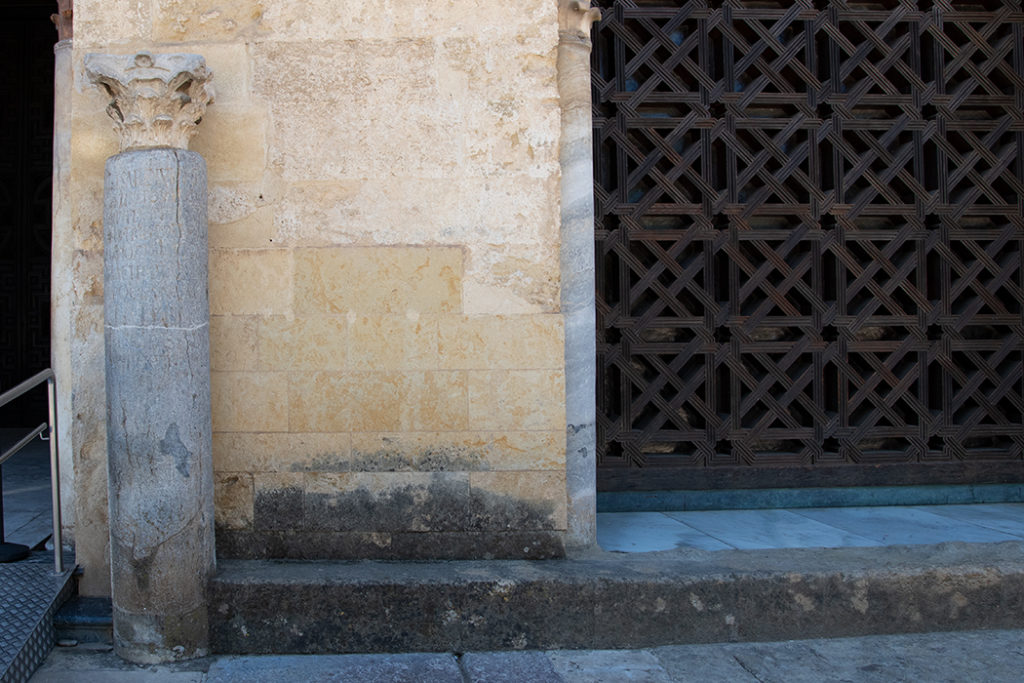
In the Patio de los Naranjos you’ll notice some free-standing columns that are quite different from the rest. These are Roman milestones. One, for example, is from via Augusta, the main Roman road that connected Cordoba to Rome. The milestone at the patio comes from Linares, a town in Jaen province.
Roman mosaics underneath the mosque
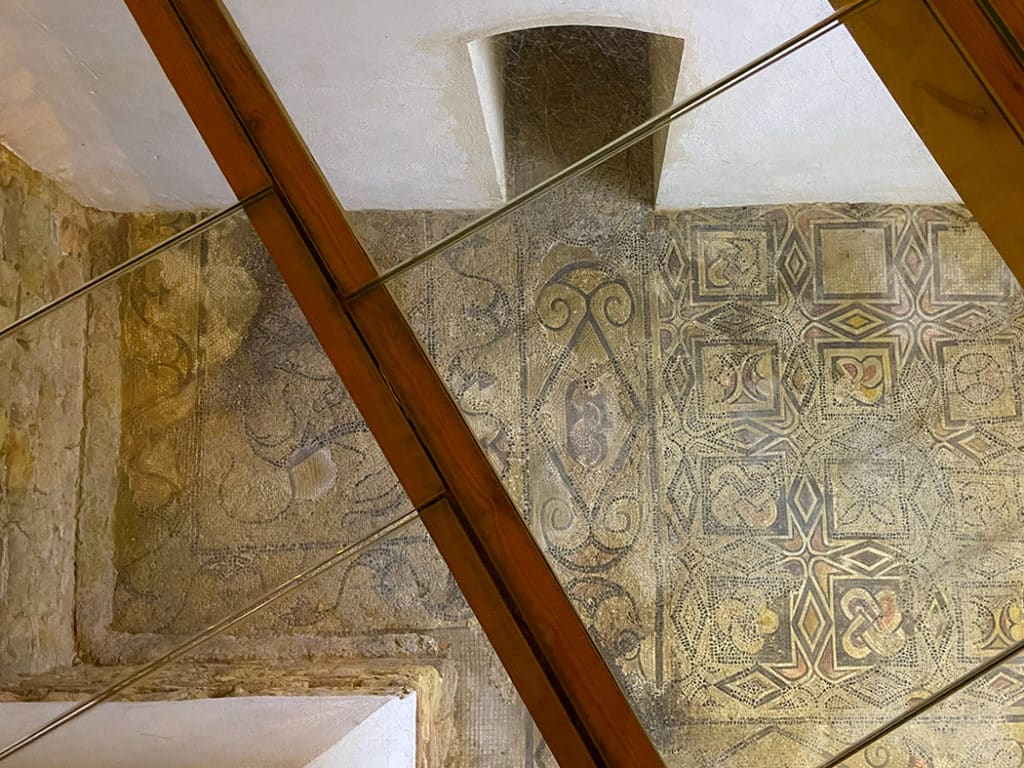
Also, in the oldest section of the Mezquita, you can see the mosaics from the Roman Church of St Vincent’s, on whose foundation the Mezquita was built. A small section of the tiles can be seen through a glass panel on the mosque’s floor.
The ceiling above the centre aisle
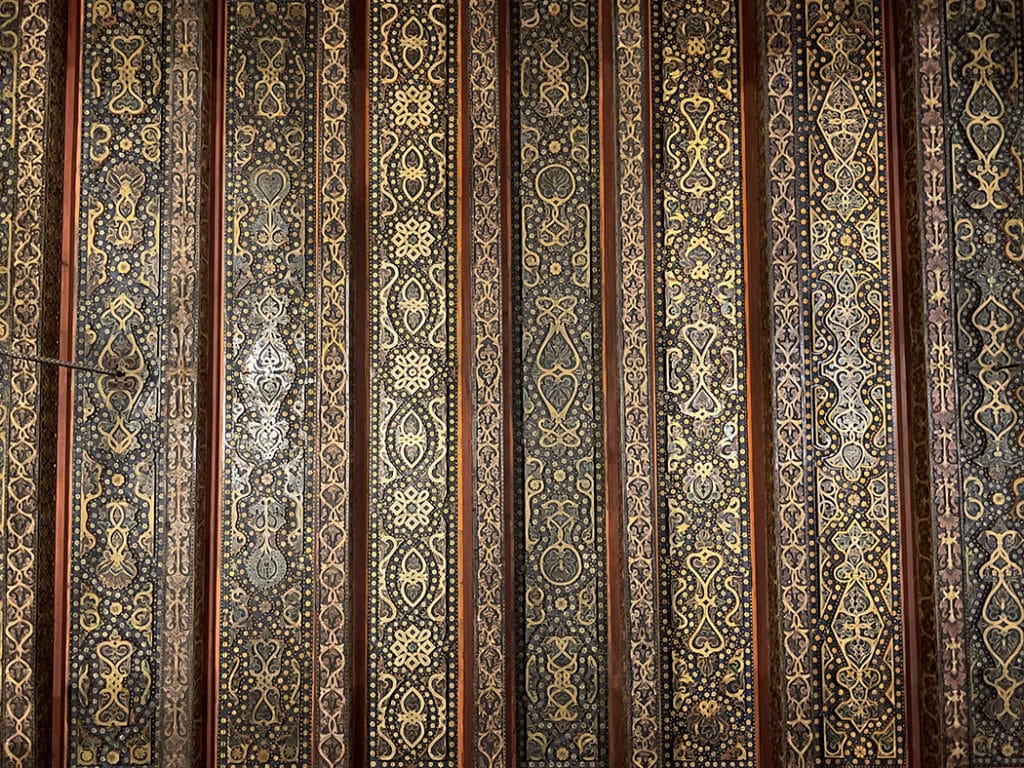
When you walk along the centre aisle – the way of the Caliph, look up to see the ornate ceiling. This is the only aisle where you can see the decorated ceiling, apart from the single panel of the original ceiling above the entrance.
Starfish fossil
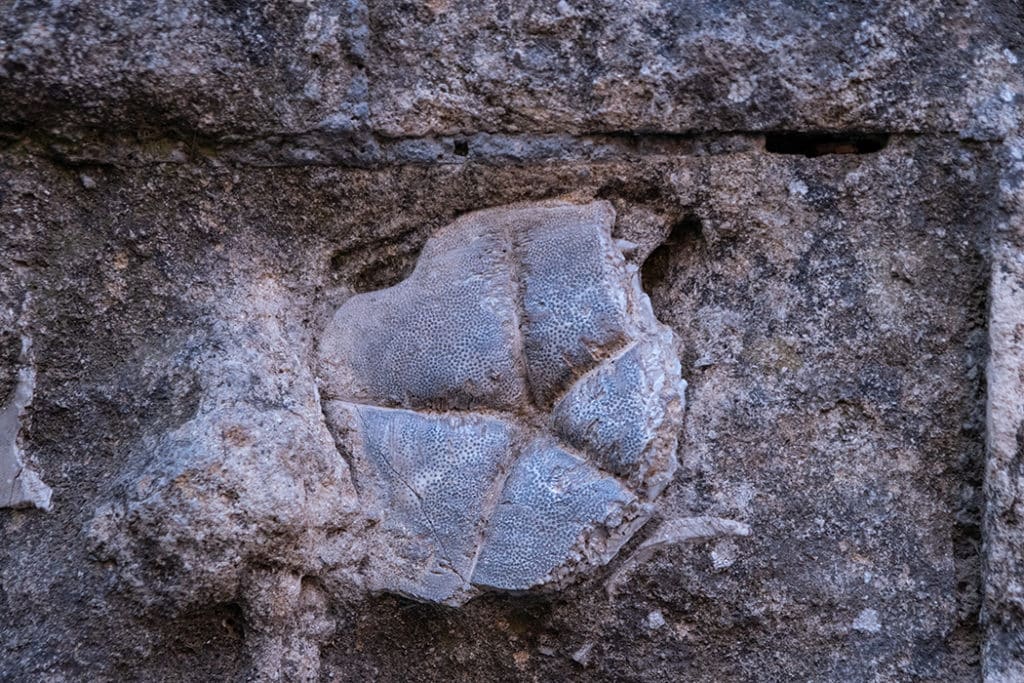
This is a quirky little gem – a starfish fossil is in the wall of the Mezquita along Calle Torrijos. You can find it at about your knee level, near the corner with Calle Corregidor Luis de La Cerda. Of course, it is considered to be a lucky star, and people like to rub it and make a wish. Given that Mesquita has lasted for over a thousand years, it may indeed be a fairly lucky fossil.
Best View of Cordoba Mosque
For the best views of the Mezquita, head across the Roman Bridge and climb to the top of Calahorra Tower – a defence tower originally built by the Arabs. Looking across the Guadalquivir River, you’ll see the Mezquita rising above the old town of Cordoba against the backdrop of the distant mountains.
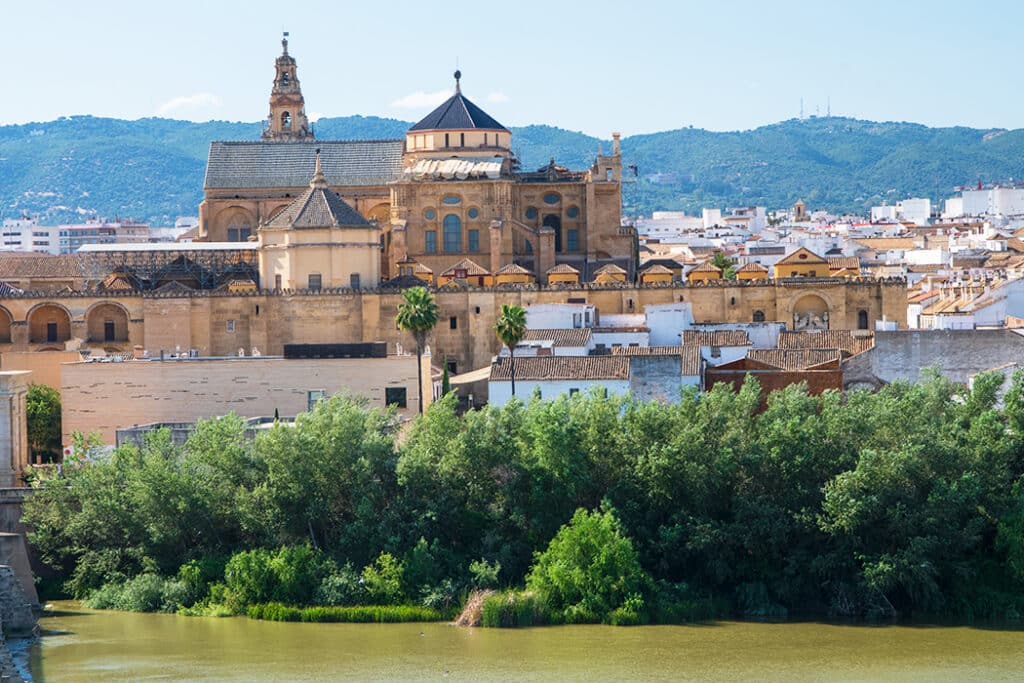
While you are here, don’t miss the miniature of the Mezquita in one of the museum rooms. There is also a miniature of Granada’s Alhambra in another room.
Best Hotel with views of the Mezquita
And if you would like to wake up to the views of the Mezquita, consider staying in the luxurious Balcon de Cordoba. It is located on a tiny street a few meters away from the Mezquita and has fabulous views from the upper floors.
And there you have it – my tips for visiting Cordoba Mezquita. Hope you enjoy your visit as much as I did.
More on Exploring Spain
- 15 Stunning Waterfalls in Spain to Add to Your Bucket List
- Alicante Old Town – The Charming Barrio Santa Cruz
- Watching Iberian lynx in Sierra de Andujar Natural Park, Spain
- 8 Amazing Things to Do in Segovia on a Day Trip from Madrid
- Discover Madrid Old Town: From the Moors to the Austrians
- Malaga Old Town: Where Romans, Moors and Picasso Meet
- 5 Gorgeous Hotels in Granada to Consider for your Next Trip
- Discover Moorish Granada in One Day on This Self-Guided Walk
- Sacromonte Caves: The Best-Kept Secret in Granada
- 17 Fabulous Weekend Breaks in Spain: Must-See Destinations and Hidden Gems

